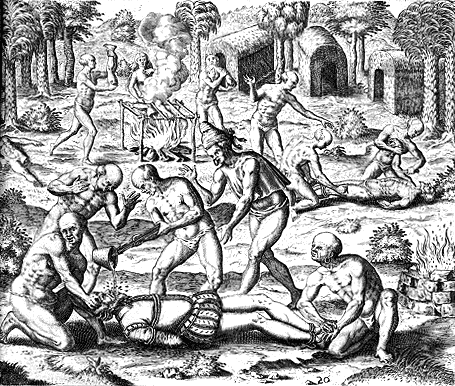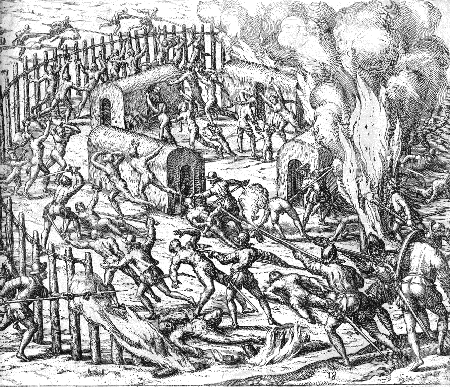Theodor De Bry
Today, an artist leads us into North America. The University of Houston's College of Engineering presents this series about the machines that make our civilization run, and the people whose ingenuity created them.
In 1570 the Spanish Inquisition lay over Flanders. Religious persecution had already driven the mapmaker Mercator off to Germany. Now Theodor De Bry also fled into Germany. De Bry was a superb copper-plate engraver, and therein hangs our tale.
Copper-plate pictures had tiptoed in alongside Gutenberg's new printing press in the late 1400s. The first printed books were seldom illustrated. When they were, it was with woodcut prints. Copper plates gave better pictures and a lot more copies, but you couldn't print them on regular letter presses. They were expensive and hard to make. Mapmakers like Mercator took up copper plate in the mid-1500s. After that, its use began to spread.
In 1590, when De Bry was 62, he and his two sons began a huge book project. They gathered up every available picture and description from the new voyages of exploration. By 1634 the family had used them to create 30 books filled with hundreds of stunning and exotic copper-plate illustrations.
The De Brys redrew pictures and expanded the stories that went with them. They didn't know how to draw American Indians, so they made them look Graeco-Roman. They mixed up cultural details -- like putting Indians from opposite hemispheres in the same picture. Still, these are the most detailed reports of the 16th-century Americas we have.
But the De Brys were Protestant, and they were landlubbers. They had no knowledge of our Native Americans and no love for their Catholic invaders. The results are, predictably, appalling.
The De Brys show us cannibalism and slaughter -- Indians killing and eating Spaniards, Spaniards killing Indians. Strange Shaman rites, along with everyday industry. They stirred in a thematic gallery of recurring grotesque figures. Anthropologist Bernadette Bucher speaks of the semantic wealth and insidious power of this new pictorial mass medium.
The Protestant world was just beginning its own exploitation of these people. The De Brys had to fit these new races into a framework that would make exploitation seem morally acceptable. They worked their way through the data, recasting it. When they were done, they'd created the first iconography of the American Indian and unwittingly bent their historical record as they did.
But, oh, the beauty of the De Brys' copper plates! Sure, they lay halfway between the real Americas and the Land of Oz. But what wild and exotic places they created! It's no wonder that their books were followed immediately by the Protestant invasions of North America -- which, for good and for evil, most directly shaped the America that you and I occupy today.
I'm John Lienhard, at the University of Houston, where we're interested in the way inventive minds work.
(Theme music)
Bucher, B., Icon and Conquest: A Structural Analysis of Illustrations of de Bry's GREAT VOYAGES. Chicago: The University of Chicago Press, 1981.
Mayor, A.H., Prints & People: A Social History of Printed Pictures. New York: The Metropolitan Museum of Art, 1971.
The Age of The Marvelous. (Joy Kenseth, ed.) Hanover, NH: Hood Museum of Art -- Dartmouth College, 1991.
Parks, G.B., Richard Hakluyt and the English Voyages., New York: American Geographical Society, 1928, pp. 161-163. (De Bry traveled only as far as England, and he did so to meet with the English explorer Hakluyt.)
Ivins, W.M., Jr., How Prints Look. Boston: Beacon Press, 1943 (revised 1987.)
See also various encyclopedia entries on De Bry.
I am grateful to Pat Bozeman, Head of Special Collections at the UH Library, for drawing my attention to De Bry and to the UH copy of De Bry's GREAT VOYAGES, Part IV, published in 1594.

Image courtesy of Special Collections, UH Library
De Bry's image of Aztecs pouring molten gold down the throat of a Conquistador (From GREAT VOYAGES, Part IV, 1594.)

Image courtesy of Special Collections, UH Library
De Bry's image of Spanish soldiers murdering Native Americans (From GREAT VOYAGES, Part IV, 1594)